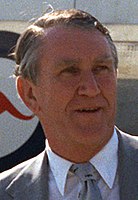
Back Elecciones federales de Australia de 1983 Spanish Élections fédérales australiennes de 1983 French
| |||||||||||||||||||||||||||||||||||||||||||
All 125 seats in the House of Representatives 63 seats were needed for a majority in the House All 64 seats in the Senate | |||||||||||||||||||||||||||||||||||||||||||
|---|---|---|---|---|---|---|---|---|---|---|---|---|---|---|---|---|---|---|---|---|---|---|---|---|---|---|---|---|---|---|---|---|---|---|---|---|---|---|---|---|---|---|---|
| Registered | 9,372,064 | ||||||||||||||||||||||||||||||||||||||||||
| Turnout | 8,870,175 (94.64%) ( | ||||||||||||||||||||||||||||||||||||||||||
| |||||||||||||||||||||||||||||||||||||||||||
 Results by division for the House of Representatives, shaded by winning party's margin of victory. | |||||||||||||||||||||||||||||||||||||||||||
| |||||||||||||||||||||||||||||||||||||||||||
The 1983 Australian federal election was held in Australia on 5 March 1983. All 125 seats in the House of Representatives and all 64 seats in the Senate were up for election, following a double dissolution. The incumbent Coalition government which had been in power since 1975, led by Malcolm Fraser (Liberal Party) and Doug Anthony (National Party), was defeated in a landslide by the opposition Labor Party led by Bob Hawke.[1]
This election marked the end of the seven year Liberal–National Coalition Fraser government and the start of the 13 year Hawke-Keating Labor government. The Coalition would spend its longest ever period in opposition and the Labor party would spend its longest ever period of government at a federal level. The Coalition would not return to government until the 1996 election.
Hawke became the second Labor leader after World War II to lead the party to victory from opposition, after Gough Whitlam in 1972 and before Kevin Rudd in 2007 and Anthony Albanese in 2022.
- ^ Butler, David (1983). "The Australian general election of 1983". Electoral Studies. 2 (2): 155–157. doi:10.1016/0261-3794(83)90058-6. ISSN 0261-3794.

